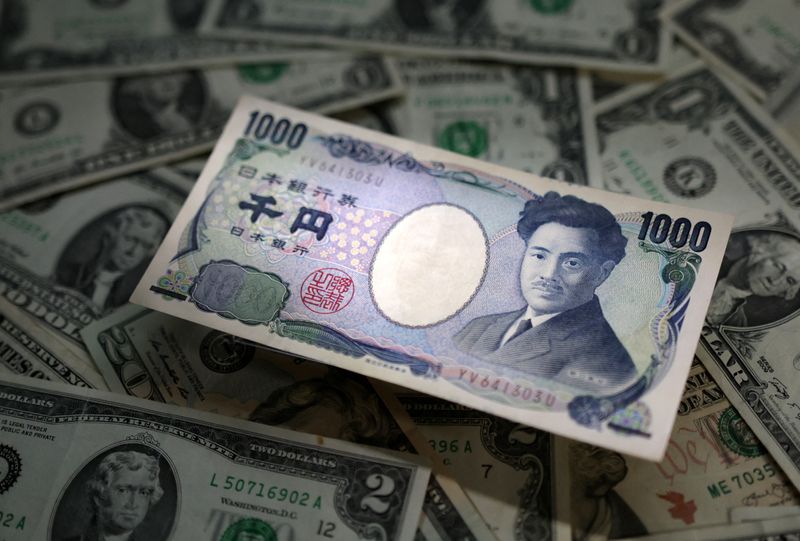Forex
Yen dives as BOJ plays down chance of hikes, soothing markets

By Harry Robertson and Ankur Banerjee
LONDON/SINGAPORE (Reuters) -The yen dropped on Wednesday after an influential Bank of Japan official played down the chances of a near-term rate hike, soothing investors’ concerns that a further jump in the Japanese currency could again rock global markets.
The yen fell about 2.5% to a session low of 147.94 per dollar following the comments from BOJ Deputy Governor Shinichi Uchida. The dollar was last up 1.9% at 147.06 yen.
“As we are seeing sharp volatility in domestic and overseas financial markets, it’s necessary to maintain current levels of monetary easing for the time being,” Uchida said.
His remarks, which contrasted with Governor Kazuo Ueda’s hawkish comments made last week when the BOJ unexpectedly raised interest rates, sent Japanese stocks higher, leaving them effectively flat for the week.
The BOJ’s hike last week, along with intervention from Tokyo in early July, led investors to bail out of once-popular carry trades in which traders borrow the yen at low rates to invest in assets that offer higher returns.
The carry unwind has combined with weak U.S. jobs data and fears about an artificial intelligence bubble to send global stocks tumbling this week, started by a 12% crash in Japanese equities on Monday.
“I think it’s become increasingly clear that the BOJ hawkish turn last week could be a policy error,” said Alvin Tan, head of Asia FX strategy at RBC Capital Markets. “Japan’s economy is actually in poor shape, especially domestic demand.”
The , which measures the currency against six rivals, rose 0.18% to 103.16, inching further above the seven-month low of 102.15 it touched on Monday.
Rong Ren Goh, a portfolio manager in the fixed income team at Eastspring Investments, said that “Uchida has saved the carry trade – for now”.
“Japan policy is one of the important moving parts of the overall risk structure in the market. The other important ones would be U.S. economic data, which in turn informs Fed policy trajectory.”
The yen’s decline was broad based, with the Mexican peso, New Zealand dollar and Australian dollar – all carry trade investment candidates – surging against the currency.
The Swiss franc, another currency that was used to fund carry trades, like the yen, was down around 1.1% to 0.8612 per dollar.
The euro eased 0.1% to $1.0919, down from an eight-month high of $1.101 hit on Monday as the dollar dropped. Sterling was 0.27% higher at $1.2727.
Traders ramped up their bets on Federal Reserve rate cuts on Monday following an unexpected jump in the unemployment rate on Friday, at one point pricing in more than 125 basis points of reductions this year.
Those bets have gradually come down, and traders on Wednesday were expecting 100 bps of easing this year and a 62% chance of a 50 bp cut in September, having priced it as a near certainty on Monday.
In other currencies, the Australian dollar was 0.67% higher at $0.6563, a day after the central bank ruled out the possibility of an interest rate cut this year, saying core inflation is expected to come down only slowly.

The has struggled in recent days, sinking to eight-month lows on Monday in the wake of the global market meltdown but perked up on the day following BOJ comments.
The New Zealand dollar was up 1.05% at $0.6017 following strong jobs data.

 Forex3 years ago
Forex3 years agoForex Today: the dollar is gaining strength amid gloomy sentiment at the start of the Fed’s week

 Forex3 years ago
Forex3 years agoUnbiased review of Pocket Option broker

 Forex3 years ago
Forex3 years agoDollar to pound sterling exchange rate today: Pound plummeted to its lowest since 1985

 Forex3 years ago
Forex3 years agoHow is the Australian dollar doing today?

 Cryptocurrency3 years ago
Cryptocurrency3 years agoWhat happened in the crypto market – current events today

 World3 years ago
World3 years agoWhy are modern video games an art form?

 Commodities3 years ago
Commodities3 years agoCopper continues to fall in price on expectations of lower demand in China

 Economy3 years ago
Economy3 years agoCrude oil tankers double in price due to EU anti-Russian sanctions

























